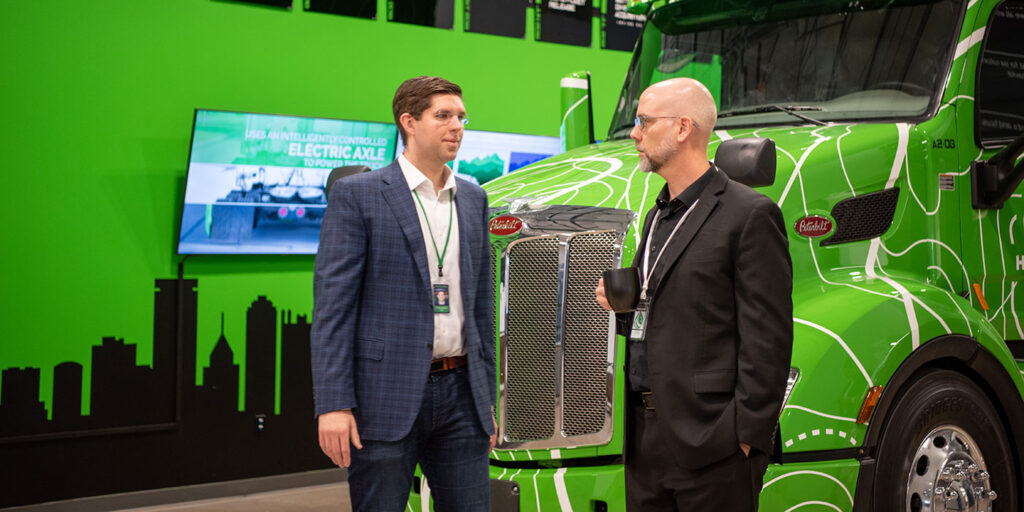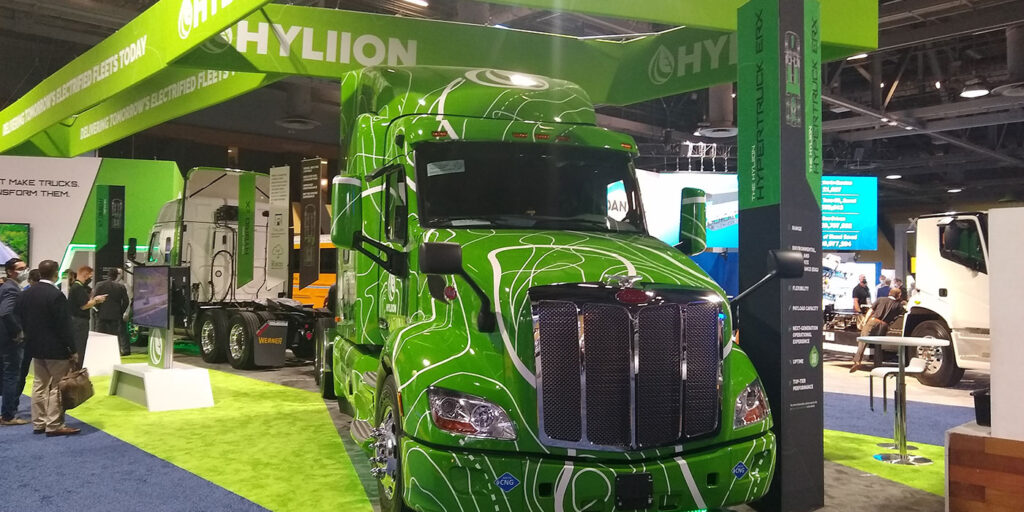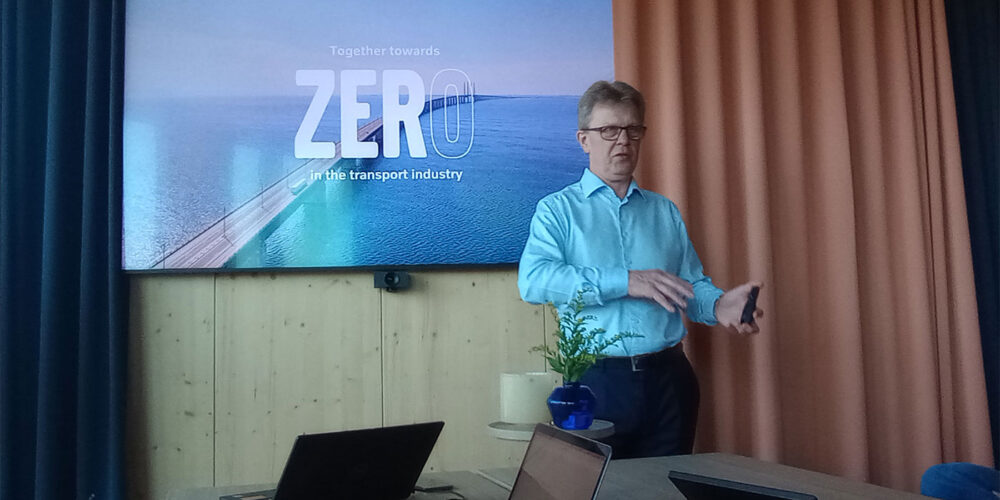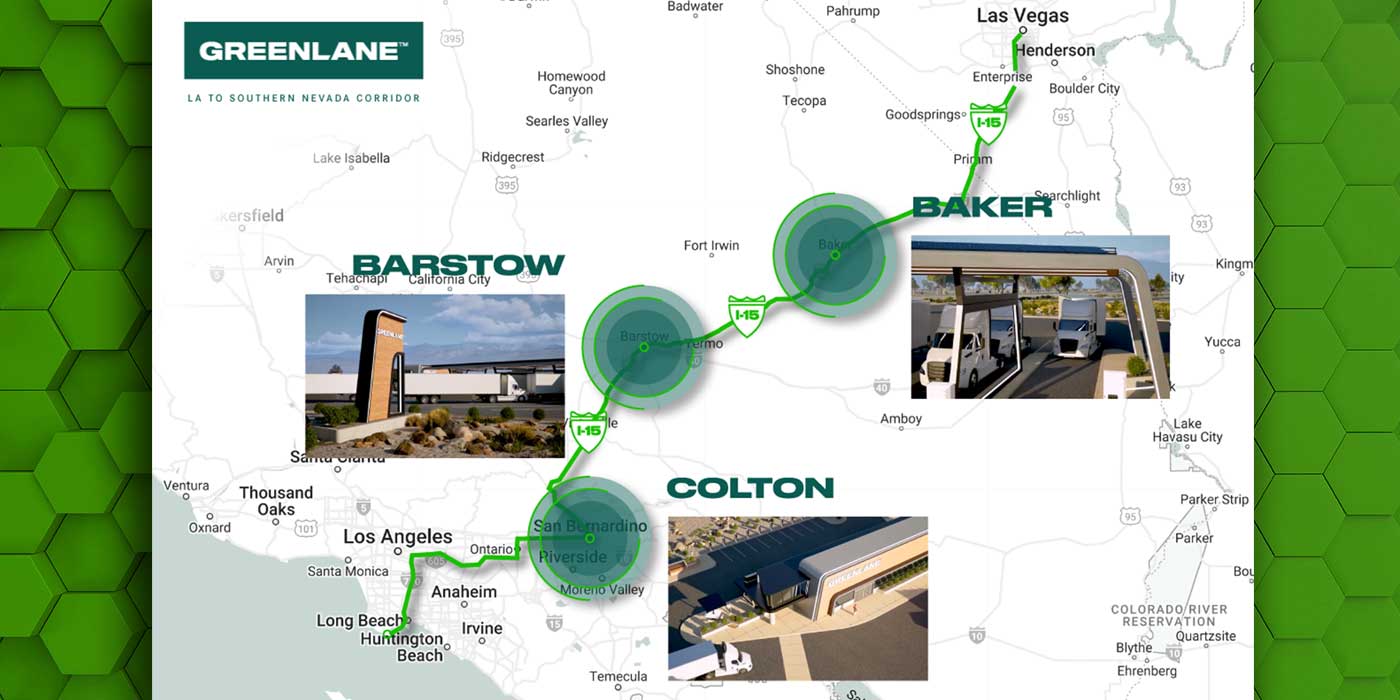When you say the word “hybrid” fleet manager faces tend to scrunch up with incredulity. Now say “hydrogen fuel cells” and eyebrows raise and heads nod and the questions start coming.
How is this fair?
In today’s trucking world that’s driving slow and steady toward increased electrification, it can be overlooked that the “what if” hydrogen fuel cells are also hybrid powertrains–the hydrogen fuel cell creates energy to drive an electric powertrain. With hydrogen, EV range extends well beyond 500 miles and fleet managers exhale relief. But take the hydrogen fuel cell out of the equation and you still have an electric powertrain.
The challenge today is that hydrogen fuel cells aren’t quite ready for heavy-duty prime time. Cost and infrastructure questions still need to be worked out before the zero-emissions trucks hit the road in long-haul applications. The keyword in that phrase is “zero-emissions.” That’s where the hybrid sticking point is. Toss a diesel engine into an electric powertrain and you’re still burning fossil fuel.
Hyliion thinks it has the answer that bridges the current decarbonization gap, taking it from “what if this works” to “this already works, what do you want to do now?”
Enter the Hyliion Hypertruck ERX–an electric powertrain Peterbilt Model 579 with onboard batteries that are charged using a natural gas generator to achieve an approximate 1,000-mile range on a single tank. (ERX stands for “electric range extender”). Functionally, it feels very much like an electric truck (because it is)–you have instant torque and a quieter ride compared to diesel. But that range though. A thousand miles.
“A year or two ago, we were in the moment of everyone saying, ‘I’m going electric. It’s happening.’ Now we’re in the reality of: How am I actually going to do this? Do I have grid capacity? Is hydrogen available? Do I have routes that are only 100 miles a day?” said Thomas Healy, founder and CEO, Hyliion. “I talked with a fleet of more than a thousand trucks, and I asked him, ‘How much of your fleet can run a battery electric truck?’’ His answer was 5% could be run on battery electric–and they’re running some today–but 95% would need more range.”
The caveat is the natural gas generator. You’re still burning fuel that has an environmental impact. You still need infrastructure. You still have questions about hybrid ROI. You still have to make sure the CNG engine has the durability and wherewithal to go the long-haul distance.
So let’s dive into it with Healy and see if we can poke some holes in hybrids, or maybe we’ll come away with a better understanding of putting together a truck equipment strategy that marches toward decarbonization, with the ability to take the first step today.

What about CNG emissions?
The whole point of an electric powertrain is to try to cut carbon emissions. Utilizing a CNG generator to power an EV driveline seems to fly in the face of that. And yes, you’re still producing emissions at the (generator) tailpipe, but according to the U.S. Department of Energy, “Heavy-duty natural gas vehicles can provide small to moderate GHG reduction benefits compared to diesel throughout the fuel life cycle.”
So it’s a step in the right decarbonization direction in reducing overall emissions, and while Healy concedes that a CNG is producing emissions, he’d also answer with a question of his own:
What’s the source of your natural gas?
“When we think of natural gas, we normally think of fracked fuel, right? But there’s renewable natural gas, which captures methane or pollution coming off of areas like landfills, dairy farms and wastewater treatment plants and uses it as a fuel,” Healy said. “If you can take pollution to power a truck or charge a battery pack, that’s a big win-win solution.”
Just so we’re clear: Renewable natural gas is used just like compressed natural gas, it just comes from renewable resources. To get a bit more into the RNG details, again here’s the U.S. Department of Energy:
“To fuel vehicles, biogas must be processed to a higher purity standard. This process is called conditioning or upgrading, and involves the removal of water, carbon dioxide, hydrogen sulfide, and other trace elements. The resulting RNG, or biomethane, has a higher content of methane than raw biogas, which makes it comparable to conventional natural gas and thus a suitable energy source in applications that require pipeline-quality gas, such as vehicle applications.”
(Click here to read more from the U.S. DOE’s take on RNG.)
“Methane production is underreported from a landfill perspective. We’ve seen studies in the past 12 months showing that landfills are two or three times the amount of pollution production from a methane perspective, and methane is a very significant greenhouse gas,” Healy said. “So with renewable natural gas, you’re kind of solving two problems right.”
(Here’s one of those types of reports.)
RNG is the lynchpin in natural gas usage. Healy explained that, essentially, the emissions that are coming out of the CNG’s generator on the Hyliion Hypertruck ERX are offset, and even overcome by the emissions that RNG is taking out of the environment.
“You can actually get negative emission scores, meaning below zero emissions,” he said. “We’ve had some discussions with fleets where they’ve said, ’If I can get a negative emission score out of my trucks, then you could offset some of my positive emissions running my warehouses or things like that. That way you actually give me a realistic way to get to a zero net company.”
“Shippers customers are demanding these types of scores from fleets,” added Jason Schieck, director, product marketing and strategy, Hyliion. “To the point where we’ve heard about carriers talking about selling carbon credits through the usage of the Hypertruck ERX. You’re starting to see a confluence of these factors that are really pushing the trucking industry to think more about the holistic problem that we’re trying to solve and not just kind of a piece of it.”
Fuel sourcing is a complicated question, but to be fair, it’s a question that should be asked of plug-in battery electric vehicles as well. Just because there are no emissions at the tailpipe doesn’t mean no emissions were created to produce the fuel. It’s a question that needs to be asked of every truck powertrain.
RNG sounds good, but where do we get it?
And we’re back to the infrastructure question. Compared to plug-in battery EVs, CNG, in general, has a leg up on the competition with 696 public CNG fueling locations suitable for heavy-duty truck applications across North America, according to the U.S. Department of Energy, and over 1,200 when you take into account private stations. (You can play around with the public CNG fueling station location finder here.)
It’s a solid start for public fueling in a time when fleets are looking to buy plug-in battery electric trucks and are having sticker shock when it comes to the cost of electric charging infrastructure installation. And that’s even if they can get a utility to help them with the project.
“The reality is that some fleets can’t get the capacity they need. And the capacity they can get is going to increase the usage of the grid. The utility could then kick on their coal-fired power plants in order to supply that.”
But now let’s get to the natural gas kicker, how many are RENEWABLE natural gas? Because if we’re going to do this decarbonization thing, let’s do it like it counts.
“Last year, we surpassed that over 50% of the fuel sold at CNG stations actually came from renewable sources,” Healy said. “So it’s out there, it’s available and it’s inexpensive”
According to a March 2021 report by Argonne National Laboratory, a U.S. Department of Energy Laboratory run by UChicago Argonne LLC, “Until recently, RNG was available primarily in California, where its very low carbon intensity made it a valuable option for meeting that state’s Low Carbon Fuel Standard (LCFS). With RNG production growing in California, and other states—and utilities—seeking to reduce the carbon content of fuels, RNG is becoming more widely available. Some nationwide fuel retailers are beginning to supply RNG to their fleet customers outside of California, and major fleets like Anheuser-Busch and New York’s Metropolitan Transportation Authority have announced plans to use RNG.”
Let’s talk RNG ROI
A common refrain is that we’ve been down the CNG road before, and it didn’t quite go anywhere except for some specific applications. (To be fair, we could say the same about early EVs well before the current iteration that are well-suited for specific applications.) The Hyliion Hypertruck ERX is different because there’s the reduced maintenance benefit of an electric powertrain.
“We’re somewhere in the middle of the spectrum between an electric truck, which is advertised as less maintenance, and a typical CNG truck,” Healy said. “We do envision brake wear and tear will be less because of the regen braking. We have seen historical data on internal combustion engines that run on natural gas that indicate that CNG engines are cleaner and easier on the engine than a diesel engine is. Technicians have told us that you pull the drain plug, you look at the oil and it’s clean.”
Hyliion noted that the CNG generator on-board the Hypertruck ERX is expected to run for the majority of the time the vehicle is in use. The operational comparison to diesel in on-highway duty cycles is yet to be determined.
“Given how the CNG generator is operated in the system, which is in a relative steady-state at a high-level of efficiency, we believe that it will be net-positive from an operating life perspective,” Healy noted. “That hypothesis will be subject to testing/validation in the coming 12-months or so.
“The ROI target of the Hypertruck ERX is to be comparable to the life of these other diesel trucks,” he continued. “We’re looking at lives that could be in the realm of what fleets are used to out of a diesel truck.”
The long decarbonization road ahead
Healy noted that while a CNG generator (using RNG) is the hybrid solution for today’s Hypertruck ERX, a hydrogen fuel cell replacing the CNG generator could be in the Hypertruck’s future. The rest of the powertrain would remain relatively the same, though it too will evolve just like its plug-in battery-driven brethren today.
Hyliion is hard at work building its own battery packs and completing its own integration. When asked how different can electric trucks be if a bulk of the industry is sourcing batteries and electric axles from the same handful of sources, Healy noted that the construction, programming and integration of the battery packs and the driveline systems can impact the truck’s operational efficiency by 50% when put up against a comparable electric-drive truck.
In terms of availability, Hyliion is working with Peterbilt to upfit the Model 579 chassis and cab with its Hypertruck ERX powertrain. From the fleet point of view, Hyliion’s Hypertruck ERX is purchased from Hyliion with service and aftersales support in their court.
“The focus today is getting the Hypertruck ERX out to fleets. It’s about seeing customer demand for this product, signing fleets up for the early production slots, and getting it deployed into fleet operations,” Healy said. “As we look at the years ahead, it’s going back to that question of: How do we keep on making that generator better and better? Evolving the efficiency of the power plant. That will be a staple for Hyliion going forward.”
More from Hyliion
Click below for a Hyliion Hypertruck ERX ride-along video and completely different interview with Healy, as well as earlier conversations with Hyliion.














